LisbonLisboaPortugal.com
The best independent guide to Lisbon
LisbonLisboaPortugal.com
The best independent guide to Lisbon
Home - Top 10 - Undiscovered Lisbon - Where to stay? - Costs - 24 hours - 3 Days - 1 Week - Day trips - Beaches
The Elevador da Bica funicular – an independent tourism guide for 2024
The Ascensor da Bica is a delightful funicular train line that connects the Cais de Sodre neighbourhood with the Bairro Alto neighbourhood at the top of the hill.
Often referred to as the Elevador da Bica, it is not only one of the most famous sights of Lisbon, but also a valuable means of transport.
This charming funicular connects two of the most popular tourist areas of Lisbon, and is an engineering marvel from a bygone industrial era. The two carriages are painted a cheery yellow colour, while inside, there is polished wood panelling and brass driver controls.
The Elevador da Bica is the most popular of Lisbon's three funiculars (the other two being Glória and Lavra), due to its quaint setting and views down to the Tejo estuary. The downside of its popularity is that there can be long queues to ride it, and you may be forced to stand in the carriage at peak times.
Also, as Bica lies at the heart of the nightlife and artisan centre of Lisbon, the funicular is often covered in graffiti. Upon your visit, it may not look as pristine as in the images you see in this guide.
This article will provide an independent tourist guide to the Ascensor da Bica, helping you get the most from your journey on it.

Carriage 2 waiting at the top of the Elevador da Bica
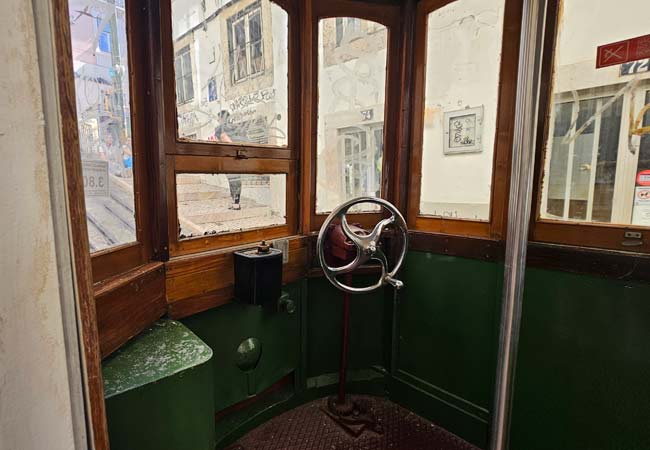
The traditional dials and levers of the funicular
What is a funicular?
Funiculars are a highly-efficient mode of transport for taking passengers up and down steep hills. The system works by connecting two carriages to a cable that passes through a pulley at the top of the hill.
As one carriage climbs the hill, it is aided by the weight of the other carriage as it descends, therefore requiring less power to operate.
Normally, the motor used to pull the carriages is located at the top of the hill, but Lisbon's funiculars are unique, as there are electric motors located beneath each of the carriages.
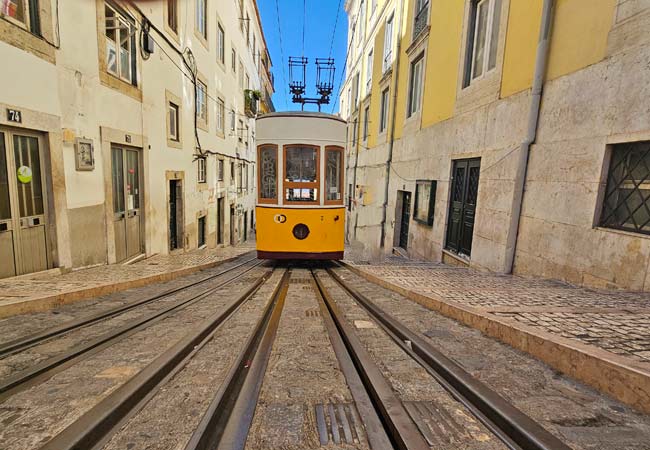
The cable used to pull the Elevador da Bica is hidden below the street, and from a distance, it looks like a third rail
Is it worth riding the Bica funicular?
It depends on which direction you're riding, why you want to ride it and how busy it is.
If you want to ride it purely for the tourist experience, go ahead - but be warned that it's a short journey (about 3 minutes). Normally there is a shorter queue at the bottom station.
If you want to ride the Elevador da Bica for its intended purpose, namely to get to the top of the hill from Cais de Sodre, then it is definitely worth it. The hill is steep and a very demanding walk in the summer. For this journey, it's advisable to have a 24-hour public transport ticket or a zapping ticket (details later).
If you want to ride it downhill to get to Cais de Sodre, then it's not worth it. The downhill walk will be quicker than the funicular ride, and the Bica neighbourhood is pretty to walk through.
If you just want to take some photos of the funicular and its distinctive tracks, then head to the Elevador do Lavra, as it is always much quieter.

The lower carriage waiting in the station
Tourist details for the Ascensor da Bica
The Ascensor da Bica connects the Rua de São Paul (in Cais de Sodre) to the Rua do Loreto on the edge of the Bairro Alto district. The 283-metre route passes through the entire length of the Bairro da Bica neighbourhood, which gives the funicular its name.
The Elevador da Bica climbs a steep hill with an average gradient of 11 per cent, which is the least steep of Lisbon's three funiculars – Lavra has a gradient of 23 per cent!
A return ride costs €3.80, but there are more affordable options (detailed later) than buying a ticket from the driver upon boarding. There are no single tickets, and the on-board fare can only be purchased with cash; card payments are not accepted. The ride on the funicular is short (5 minutes), and the tourist experience can feel a little disappointing if you have paid full price and stood in a long queue.
The funicular starts at 7am from Monday to Saturday and 9am on Sundays, and it continues operating until 9pm. There is a departure every 12 minutes during peak times.
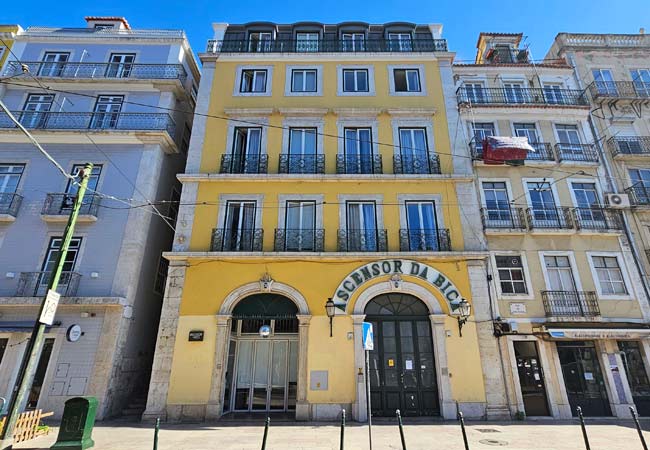
The entrance to the low-level station on the Rua de São Paul is easy to miss, as it looks identical to the surrounding buildings.
There can be long queues to ride it from the upper stop, as this is close to the tourist area of Bairro Alto. Also, passengers may be forced to stand in the carriages at peak times, which is no fun. Each small carriage has the capacity for 23 passengers; 9 seated and 14 standing. If there is a long queue, consider returning later or heading to the much quieter Elevador do Lavra. The best times to ride the Ascensor da Bica are early in the day (before 10am) or after 4pm.
The Ascensor da Bica is part of the public transport network of Lisbon, which is operated by Carris, and the funicular is the '53E' route.
Insight: Before riding the funicular down to Cais de Sodre, make sure you visit the Miradouro de Santa Catarina, one of the best viewpoints of central Lisbon, which is close to the Elevador da Bica.
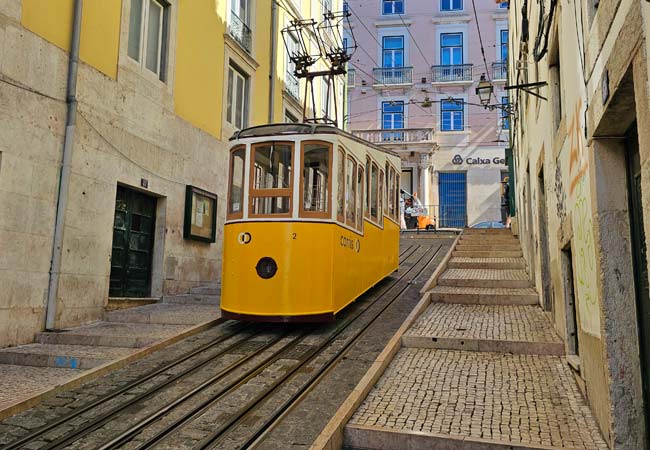
Better ways to pay for the Ascensor da Bica
The cash fare for the Elevador da Bica is expensive and purely designed to exploit tourists, but is justified by Carris (the public transport company) due to the inconvenience of handling cash.
There are much cheaper options for paying for a ride on Bica, depending on how much you will use public transport during your day of sightseeing.
If you plan to use a lot of public transport during your day, there is a 24-hour ticket that costs €6.80. This includes all funiculars, trams, the metro and buses and is exceptional value, especially if you’re intending to ride the number 28 tram (€3 single), the Elevador da Glória (€3.80), and the Elevador de Santa Justa (€5.30!) within the 24hour period.
The other option, if you intend to use less public transport, is to use a zapping ticket. This process involves loading credit onto a Navegante card (€0.50 for the initial purchase) and offers reduced fares, such as €1.70 for the Ascensor da Bica.
Annoyingly, both the 24-hour ticket and the zapping ticket can only be purchased from a ticket machine in a metro station. The nearest metro station is Cais do Sodré, which is at the bottom of the hill.
Tip: A zapping ticket loaded with at least €15 is highly recommended for your stay in Lisbon, as it simplifies travelling by public transport and can also be used to pay for the train to Sintra or Cascais.
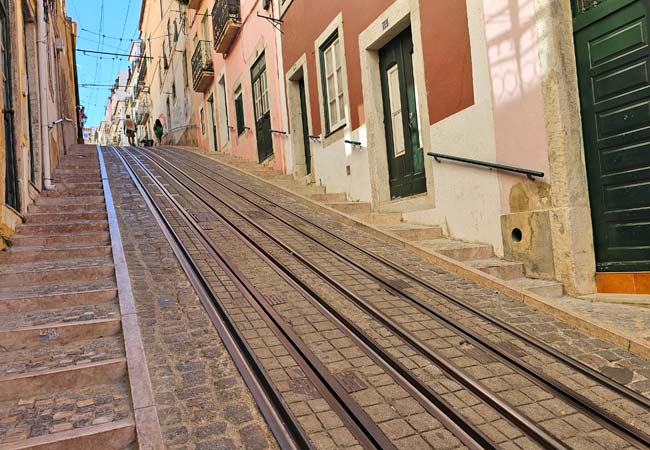
The Bairro da Bica is a pretty neighbourhood, and it is a pleasant walk to the bottom of the funicular line
History of the Elevador da Bica
The Elevador da Bica was the third funicular to be installed in Lisbon, with its first service launching on June 28, 1892. The funicular and its clever, water-powered system was created by Portuguese engineer Raoul Mesnier du Ponsard, who studied under Gustave Eiffel (designer of the Eiffel Tower in Paris).
The original 1880s water-powered tram worked by filling and emptying reservoirs on the roof of the carriages, with gravity then causing them to travel along the tracks. When the upper carriage wanted to descend, it would add more water to its reservoir, with this increased weight pulling it to the bottom and hauling the other carriage uphill.
This original water design influenced how the funiculars worked when they came to be steam powered and electrified, as the power was added to the carriages - which is unusual for most funiculars.
The funicular was converted to steam power in 1896, then electrified in 1924 with the two carriages that operate today.
Discover more of Lisbon with our most popular guides
Thank you,
We really appreciate you visiting our website, but the digital world is changing for the worse.
Independent publishers like us face many new challenges. Search engines now prioritize ads over organic content, and AI replicates our hard work.
If you enjoyed our work, please bookmark our website to easily find us again or share it on social media with your friends and family.
We aim to keep our 1,600+ pages accurate and fully updated. If you spot any errors or outdated information, please contact us at: [email protected]
A complete list of all of our Lisbon articles
Please help us
The digital landscape has shifted, squeezing small publishers like us. Between search engine biases and AI plagiarism, we're feeling the heat.
All we ask is that you bookmark us for quick access and share the articles you love.
Spotted an error? Let us know - with over 1,600 pages to maintain, we always welcome your vigilance.
Please contact us at: [email protected]































